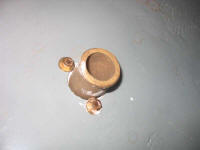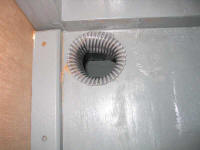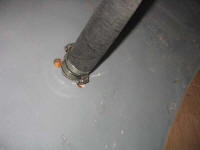
|
|
~MENU~ |
| Home |
| The Concept |
| The Boat |
| Bringing Her Home |
|
Weekly Progress Log |
|
Daysailor Projects |
| The Boat Barn |
| Resources |
| Other Sites |
| Email Tim |
|
|
|
Systems: Diesel Exhaust System |
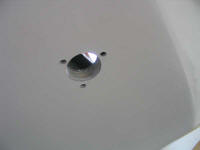 I
began the exhaust installation at the transom. I purchased a
bronze exhaust outlet appropriately sized for the exhaust hose
needed--1-1/2" in this case, and now prepared to install it.
First, I chose the desired location on the outside, marked it, and
drilled a hole to allow the fitting to slip through. Then, I
marked and drilled pilot holes for the three mounting bolts.
Removing the fitting, I tapped the holes for 1/4-20 bolts, and then
drilled small countersinks beneath each fastener location to provide a
small reservoir of sealant when they were installed. I
began the exhaust installation at the transom. I purchased a
bronze exhaust outlet appropriately sized for the exhaust hose
needed--1-1/2" in this case, and now prepared to install it.
First, I chose the desired location on the outside, marked it, and
drilled a hole to allow the fitting to slip through. Then, I
marked and drilled pilot holes for the three mounting bolts.
Removing the fitting, I tapped the holes for 1/4-20 bolts, and then
drilled small countersinks beneath each fastener location to provide a
small reservoir of sealant when they were installed. |
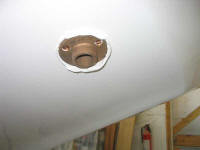 After
confirming the setup, I installed the fitting in a heavy bed of
polysulfide, and threaded in the three fasteners. Then, from
inside, I applied washers and nuts to the protruding bolts and tightened
them down. To allow the hose to properly fit over the fitting, I
then cut off the excess bolt length. After
confirming the setup, I installed the fitting in a heavy bed of
polysulfide, and threaded in the three fasteners. Then, from
inside, I applied washers and nuts to the protruding bolts and tightened
them down. To allow the hose to properly fit over the fitting, I
then cut off the excess bolt length. |
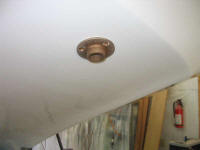 With
the fitting installed and the excess sealant cleaned up, I began to run
the exhaust hose. I had a 12-foot section of wire-reinforced
exhaust hose on hand, so I decided to begin at the transom. From
inside the engine room, up beneath the port sidedeck, I drilled a large
hole through the after bulkhead--large enough to allow passage of the
hose, plus a strip of split hose that I wrapped around the inside
of the opening as chafe protection. With
the fitting installed and the excess sealant cleaned up, I began to run
the exhaust hose. I had a 12-foot section of wire-reinforced
exhaust hose on hand, so I decided to begin at the transom. From
inside the engine room, up beneath the port sidedeck, I drilled a large
hole through the after bulkhead--large enough to allow passage of the
hose, plus a strip of split hose that I wrapped around the inside
of the opening as chafe protection. |
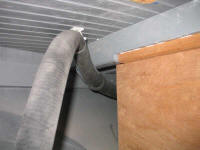 With
that complete, I ran the hose through to the transom, where I secured it
to the new fitting with double hose clamps. Then, I routed the
hose up to just beneath the deck, and secured it in place with cushion
clamps and, in one spot, a cable tie. This elevated loop
immediately at the transom fitting would help prevent backflow of
seawater into the exhaust system. With
that complete, I ran the hose through to the transom, where I secured it
to the new fitting with double hose clamps. Then, I routed the
hose up to just beneath the deck, and secured it in place with cushion
clamps and, in one spot, a cable tie. This elevated loop
immediately at the transom fitting would help prevent backflow of
seawater into the exhaust system. |
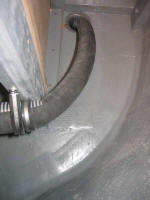 Next,
I pulled the slack forward into the next compartment, and secured the
hose with more cushion clamps. Then, I turned my attention to the
waterlift. I had purchased a fiberglass waterlift, and now chose a
location just to port of the engine, but still below the exhaust
manifold outlet for best performance and protection.
After confirming the location, I secured the waterlift to the hull
(after grinding away the paint on the hull) with thickened epoxy
adhesive, and left it to cure overnight. Next,
I pulled the slack forward into the next compartment, and secured the
hose with more cushion clamps. Then, I turned my attention to the
waterlift. I had purchased a fiberglass waterlift, and now chose a
location just to port of the engine, but still below the exhaust
manifold outlet for best performance and protection.
After confirming the location, I secured the waterlift to the hull
(after grinding away the paint on the hull) with thickened epoxy
adhesive, and left it to cure overnight. |
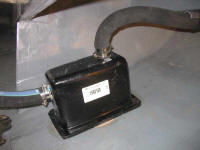 In
the morning, with the waterlift now permanently secured, I cut and fit
the hose run from the transom, securing it to the outlet on the
waterlift. With the remaining hose, I connected the engine exhaust
manifold to the inlet on the waterlift, completing the system, In
the morning, with the waterlift now permanently secured, I cut and fit
the hose run from the transom, securing it to the outlet on the
waterlift. With the remaining hose, I connected the engine exhaust
manifold to the inlet on the waterlift, completing the system, |
| Back to the Main Menu> |
